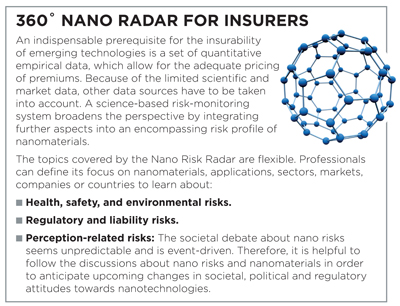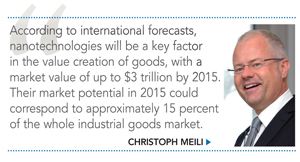 Nanomaterials are commonly used inmany industrial and consumer products. Aside from theirbeneficial properties, certain nanomaterials can also posesubstantial risks to human health and the environment.Nanomaterials are implicitly covered in insurance policies.Liability insurers should therefore check their portfolios andinvestigate whether and what kind of nano-related risks are coveredin their policies.
Nanomaterials are commonly used inmany industrial and consumer products. Aside from theirbeneficial properties, certain nanomaterials can also posesubstantial risks to human health and the environment.Nanomaterials are implicitly covered in insurance policies.Liability insurers should therefore check their portfolios andinvestigate whether and what kind of nano-related risks are coveredin their policies.
At the same time, insurers must stay abreast of new scientificdata about potential risks of specific nanomaterials and regulatorydevelopments, which must be followed continuously. Unexpectedlosses in liability lines of business could be avoided, ifappropriate underwriting options are developedtimely.
|Increasing Nano Product Sales
From self-cleaning windows andscratch-resistant colors and lacquers, to transparent sunscreens,antimicrobial plastering, packaging materials and textiles, anarray of nano products are available. There are a fast-growingnumber of industry and consumer products which containnanomaterials (NM). According to the European Commission,“nanomaterial” refers to a natural, incidental or manufacturedmaterial containing particles, in an unbound state or as anaggregate or as an agglomerate and where, for 50 percent or more ofthe particles in the number size distribution, one or more externaldimensions is in the size range of 1-100 nm (1 nm = 10-9 m).”Compared to corresponding bulk materials, nanomaterials often shownew physical and chemical properties. Therefore they are often usedin nanotechnologically improved products andapplications.
 For example, in Germany there are approximately 2,000companies and research organizations related to nanotechnology.Forty-four percent are small- and medium-sized enterprises (SME),while 41 percent are research organizations and university labs,and 15 percent are major companies. In 2011, there were 64,000workers involved in nanotechnologies and a turnover of 14.3 billioneuro was generated by German nano companies. Because of thecross-sectional character of nanotechnologies, the sales volumes ofnanomaterials and nanoproducts are increasing in all industries. Inthe color and lacquer industry, it is projected that by 2020already 20 percent of the total business sales are generated bynano-components—for example, smart coatings—as the above mentionedantimicrobial and scratch-resistant ingredients.
For example, in Germany there are approximately 2,000companies and research organizations related to nanotechnology.Forty-four percent are small- and medium-sized enterprises (SME),while 41 percent are research organizations and university labs,and 15 percent are major companies. In 2011, there were 64,000workers involved in nanotechnologies and a turnover of 14.3 billioneuro was generated by German nano companies. Because of thecross-sectional character of nanotechnologies, the sales volumes ofnanomaterials and nanoproducts are increasing in all industries. Inthe color and lacquer industry, it is projected that by 2020already 20 percent of the total business sales are generated bynano-components—for example, smart coatings—as the above mentionedantimicrobial and scratch-resistant ingredients.
The situation in other industries is similar. According tointernational forecasts, nanotechnologies will be a key factor inthe value creation of goods, with a market value of up to $3trillion by 2015. Their market potential in 2015 could correspondto approximately 15 percent of the whole industrial goods market. Alarge part of the global goods production, for example in the areasof health, information and communication technology, energy andenvironmental technology would be based on the application ofnanotechnology knowledge.
|An Unclear RiskProfile
Nanomaterials have often beencritically discussed in the past few years with regard to theirpotential adverse effects on human health and the environment. Eventhough scientific risk research on nanomaterials has beenundertaken for over 10 years, it is still premature to determinepotential adverse effects on human health and the environment inthe mid- and longterm perspective. In addition to physical andchemical data, especially related to exposure, data is needed toaddress human and eco-toxicological effects. Nanomaterials that arebound or embedded in a solid matrix pose a low or even negligiblerisk, according to many experts. By contrast, unbound, powdered orairborne particles could be inhaled and enter the bloodstreamthrough the lungs. In the bloodstream particles can enter cells.Some particles have actually been found in the nucleus andinteracting with cellular structures.
Carbon nanotubes (CNT), which are long,fiber-shaped nano molecules have been found to cause inflammationand asbestos-cancer-like malignant tumors in mice. Nanoparticlescan also enter the body through digestion. However, there arecomparatively few data on the behavior of nanomaterials in theintestinal tract that demonstrate that titaniumdioxidenanoparticles (commonly used in food) cause inflammatory reactionsand have genotoxic effects in cells of in the intestine. In theenvironment there are persistent and bioactive nanomaterials thatare critically examined. Today no final judgment of the potentialrisks of specific nanomaterials in the middle or longtermperspective is possible. A “long-tail” risk potential for certainnanomaterials, however, cannot be excluded.
|Potential Loss Exposure
A recentstudy published by Gen Re demonstrates that nanotechnologies posepotential risks to liability insurances due to the enormous globaluse of nanomaterials in industry and consumer products. Accordingto Gen Re this could affect liability insurances in the followingliability lines of business:
- Comprehensive general liability (CGL)
- Product liability insurance
- Environmental liability insurance
- Product recall
- Workers' compensation
The increasing number of compensation claims, the complexity ofnanotechnologies and the unlimited passive legal protection forconsumers offered by liability insurance policies could easilycause tremendous costs to elaborate defense.
|In a position paper the Chief Risk-Officers Forum describesboth: the opportunities and the challenges which the insuranceindustry faces with nanotechnologies. Given the enormous economicpotential it seems vital for insurance companies not to bannanotechnologies from insurance policies. Exclusion ofnanotechnologies is no option. In fact, understanding the potentialrisks of nanomaterials and promoting risk awareness and riskmanagement among the insured companies seems to be crucial. Thus,long-term damages, as happened in the case of asbestos, could beavoided.
|Nevertheless, the Gen Re study states thattoday most insurance companies do not look into the matter of nanorisks at all. Furthermore, the current situation could be called a“waiting period” in the insurance industry. It is recommended thatthe insurance companies should rather anticipate the potentialdevelopments, monitor the ongoing risk research and internationalregulation with a systematic “Risk-Radar” (refer to the boxabove).
| No Nano Registry In Sight
No Nano Registry In Sight
Nanomaterials areregulated on national and international levels. In the EuropeanUnion, for example, there are several regulations applicable tonanomaterials. Most of the present regulations on EU level andabove do not refer explicitly to nanomaterials or nano-specificproperties of the chemicals or products. Many critics and evenauthorities argue that nanomaterials are not treated adequately incurrent regulations.
Today there is only one country in the world (France) which hasstarted a mandatory registry for nanomaterials. On the European andalso at the global level there is no official registry ofnanomaterials and nanoproducts available. A registry ofnanomaterials in the European Union has been discussed since 2008but has never been started. Therefore there is a growing lack ofinformation concerning the use and application of nanomaterials onthe market. There is a systematic shortage of data concerningnanomaterials along the value-chain. Downstream users often lackdata about nanomaterials which are used in their processes orproducts. Therefore it seems very difficult for insurance companiesto get nano-specific information and data from their insuredcustomers. Thus, liability insurers have to determine the riskprofiles in their portfolio with external data andexpertise.
|In conclusion, liability insurers have to meet the challenges ofnanotechnologies. The uncertainties in the risk profile of certainnanomaterials can be handled by:
- Checking new and existing liability policies in the portfoliosfor hidden nano risks.
- Raising customer (external) and underwriter (internal)awareness of potential nano risks.
- Developing appropriate underwriting strategies withrisk-specific signing policies
- Continuous monitoring, based on the state-of-the-art of scienceand technology.
Thus, insurers can profit from booming nanotechnologies. Theycan price their nano policies adequately. On the other hand theycan avoid unforeseen late damages and losses through “long-tail”risks of nanomaterials.
Want to continue reading?
Become a Free PropertyCasualty360 Digital Reader
Your access to unlimited PropertyCasualty360 content isn’t changing.
Once you are an ALM digital member, you’ll receive:
- All PropertyCasualty360.com news coverage, best practices, and in-depth analysis.
- Educational webcasts, resources from industry leaders, and informative newsletters.
- Other award-winning websites including BenefitsPRO.com and ThinkAdvisor.com.
Already have an account? Sign In
© 2024 ALM Global, LLC, All Rights Reserved. Request academic re-use from www.copyright.com. All other uses, submit a request to [email protected]. For more information visit Asset & Logo Licensing.








